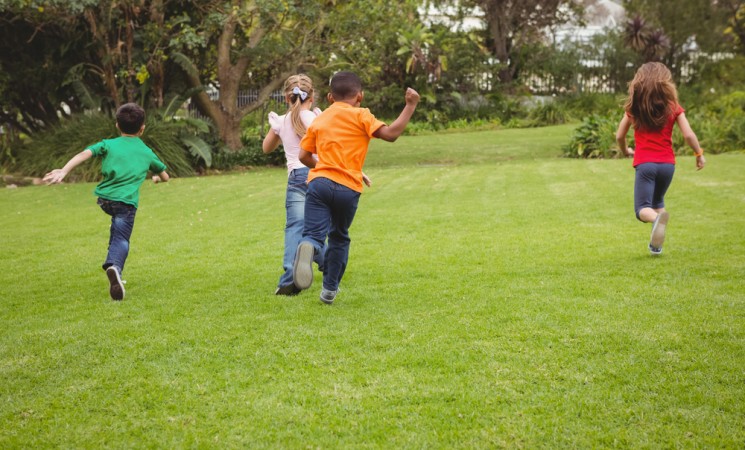Archived Content
This page is archived and provided for historical reference. The content is no longer being updated, and some of the information may have changed over time and could be outdated or inaccurate.

By Kerry L. McIver, Ph.D.
Given the epidemic of childhood obesity and the relationship between weight status and physical activity, understanding children’s physical activity behaviors is of particular public health interest. Also of interest is understanding the factors that underlie a child’s participation in physical activity across settings. Most adults assume that children are active beings by nature, but researchers have found that, even at early ages, children frequently choose inactive pursuits over active ones.
Schools have the opportunity to provide children with healthy and appropriate physical activity across the day. However, opportunities for physical activity during the school day vary greatly across the U.S. and are declining as PE and recess programming are being reduced. Other avenues for active opportunities during the school day, including classroom activity breaks and physically active lessons, are gaining momentum, but more effective interventions and additional research are needed.
Understanding children’s physical activity behaviors is of particular public health interest
Information on the physical (location and setting) and social (group composition, activity initiator, etc.) contexts of physical activity may benefit researchers and practitioners who develop and implement physical activity interventions. To date, very few measurement tools exist that can assess both children’s physical activity levels and the comprehensive context in which physical activity takes place within the school setting. One of the best ways to assess the context of physical activity is through direct observation.
Direct observation systems allow researchers to “be a fly on the wall” in settings of interest and, in this case, capture a more complete picture of a child’s or children’s physical activity behaviors. Given the importance of understanding physical activity opportunities during the school day, and the limited research in explaining the physical and social contexts related to school-day activity, researchers sought to develop a direct observation tool for use in elementary school environments.
Observational System for Recording Physical Activity in Children: Direct observation tool for elementary school environments
The Observational System for Recording Physical Activity in Children (OSRAC) is a battery of direct observation systems that use focal-child, momentary time sampling methods to observe and subsequently record a child’s behavior over pre-defined periods of time. In order to specifically address measurement of physical activity in elementary schools, the OSRAC-Elementary (OSRAC-E) was created as an extension of the battery of OSRAC direct observation systems (OSRAC-Preschool (OSRAC-P), OSRAC-Home). Using the OSRAC-P as a guide, the OSRAC-E was developed with specific contexts relevant for elementary school settings. While part of the goal was to keep some categories of codes consist across the battery of systems (physical activity intensity levels, activity types, group composition, activity initiators, and prompts for activity), development of the OSRAC-E focused on creating new categories and codes that were most salient in elementary school settings. The final version of the OSRAC-E included new categories for physical settings (i.e., gym, cafeteria, playground, classroom, library, etc.), instructional settings (i.e., art, core class, recess, lunch, PE, etc.), and context (i.e., academics, games, gross motor, transition, etc.). In total, the OSRAC-E includes 9 observational categories which are recorded for each user-defined observation period.
In order to test the newly developed system, researchers collected data in a sample of elementary school students in a diverse sample of schools. Researchers used a 5-second observe and 25-second record (30-second observation interval) cycle for 20 minutes per observation session. Data were collected on 71 children (39 boys and 32 girls; 64% white, 30% Black), 2 each from grades K-5 at 6 schools. Children were observed across 1 week, during observation windows assigned randomly across the entire school day, with particular attention given to observing PE and recess for each grade. In sum, each child was observed for 4, 20-minute sessions resulting in 11,360 observation intervals for analysis (71 children * 4 sessions * 20 minutes per session* 2 observation intervals per minute). Data analyses included examining the percent of time children spent in 3 activity intensity categories—sedentary, light, moderate-to-vigorous activity (MVPA)—by instructional setting (classroom, PE, recess).
The development of the OSRAC-E and the testing of its utility in practice suggested that the tool is reliable for use in elementary schools. Of interest, the percent of observation intervals recorded as MVPA during PE and recess was 15% and 14%, respectively. Classroom MVPA was observed in only 0.2% of the applicable observation intervals.
This study provided estimates of elementary-school aged children’s physical activity across the school day in common school contexts. In addition to these estimates of activity, our findings suggest that, although schools are important venues for activity, teachers and school staff in our study did not encourage activity when appropriate (no prompts for increased activity were observed) and provided very few opportunities for MVPA throughout the school day.
To further the understanding of physical activity behaviors of children during the school day, we encourage the use of the OSRAC-E. The OSRAC-E is well-suited to assist investigators in collecting and cataloging a rich array of contextual factors related to elementary school children’s physical activity.
For more information on the OSRAC-E, contact Kerry McIver.
Read the Article
This study was supported by NIH grant 5R01HD043125.
About the Author
 Kerry McIver, PhD, is a Research Assistant Professor in the Department of Exercise Science, in the Arnold School of Public Health, at the University of South Carolina. She is the Project Coordinator on several NIH-funded research projects focusing on children’s physical activity and health and contributes measurement expertise to several national and international studies. Her research interests lie in the measurement of physical activity and fitness in children and youth, schools as an environment for child physical activity, and developing interventions to increase physical activity and reduce obesity in children.
Kerry McIver, PhD, is a Research Assistant Professor in the Department of Exercise Science, in the Arnold School of Public Health, at the University of South Carolina. She is the Project Coordinator on several NIH-funded research projects focusing on children’s physical activity and health and contributes measurement expertise to several national and international studies. Her research interests lie in the measurement of physical activity and fitness in children and youth, schools as an environment for child physical activity, and developing interventions to increase physical activity and reduce obesity in children.








